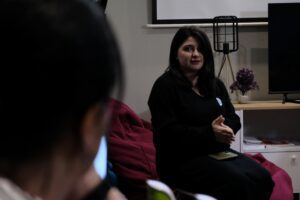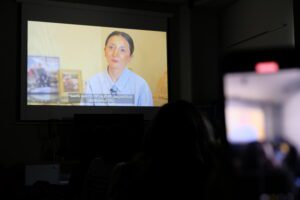- November 2, 2024
- Posted by: admin
- Category: News


The fifth exhibition of the Lratun Media Museum, titled “Episodes of Conflict Journalism,” is currently being held in Ijevan.
During the ten-day exhibition, visitors can learn how the press, television, and documentaries have covered the Karabakh conflict since 1988 through the exhibited content.
Gegham Vardanyan, the editor of the Media.am website for the Media Initiatives Center (MIC) states that Episodes of Conflict Journalism was initially presented in January 2023. However, following the Artsakh blockade and the one-day war of 2023, a need to update and enhance the exhibition emerged.
“MIC has consistently prioritized conflict coverage. We have communicated about the conflict through films, TV programs, TV bridges, and documentaries that we produced. I believe our society needs to reflect on and analyze the conflict. The materials presented during this exhibition offer both the occasion and the opportunity to do so,” says Gegham Vardanyan.
Visitors can explore archival videos, documentary photos, and multimedia projects through touch screens during the exhibition. Each project highlights a different period of the conflict.
The works of Artsakh photographer Hayk Harutyunyan are featured in the Ijevan exhibition. At only 22 years old, Hayk shares that during the blockade of Artsakh, his passion for amateur photography evolved into a profession. He felt a strong need to inform Armenia and the world about the events.
“After 2020, we woke up every morning, holding our breath, hoping for a war-free day. The day of the one-day war began peacefully, but everything changed when the first explosion echoed through the afternoon. I grabbed my camera and ran outside. For three days, I took photos non-stop, day and night, and sent them to various international news outlets. This was incredibly challenging due to the lack of connection; in some parts of the city, I had to position my hand just right for the pictures to be sent. The hardest part was expressing my anguish as a photographer, a journalist, and someone who needed to support his family,” says Hayk Harutyunyan.
Artsakh journalist Tsovinar Barkhudaryan was impressed by the extensive effort in collecting the news. Her Eyewitness project, which aired on the 5th channel, is also included in the exhibition.
“Bringing together such a wide range of materials in one place is a tremendous effort. While working on the Eyewitness project, I constantly struggled to find archival materials. Having such a well-organized valuable archive is a tremendous asset for the journalistic community,” says Tsovinar.
Mane Grigoryan, head of the Professional Media, Practitioners, and Grassroots joining Forces for Peace program at the MIC, mentioned that the exhibition will feature meetings with students, pupils, and representatives from different community representatives over the next ten days.
“There will be internal exhibitions at the Mobile Media Museum. During this time, we will showcase Levon Kalantar’s “Parts of the District” along with Mariam Sargsyan’s film “The Last Children of Artsakh,” which was created with MIC support. This exhibition is specifically for our visitors from Ijevan,” says Mane Grigoryan.
There was a moment of silence in the hall after the screening of the film The Last Children Of Artsakh. The author of the film, Artsakh journalist Mariam Sargsyan, says this is mostly always the case. Then, the silence is followed by hugs, and she understands that the key messages were delivered.
“I often reflect on how valuable it is that we created this film and documented those four stories. It’s important to remember that these four women represent the experiences of many others who faced similar challenges. I recall contacting many mothers during the preparatory phase, but many declined to participate.”
It is clear that very little time had passed. They were not yet ready to talk, but after watching the film, many wrote that they were ready to share their experience if necessary,” says Mariam Sargsyan.
The Mobile Media Museum, with a ten-year history, creates an environment during its exhibitions to discuss the media and the role of journalists.
All five exhibitions of Lratun will soon be fully available online on the revamped lratun.am website. Throughout the years, lratun exhibitions have been presented in Yerevan, Gyumri, Vanadzor, Martuni, Goris, and Kapan.










